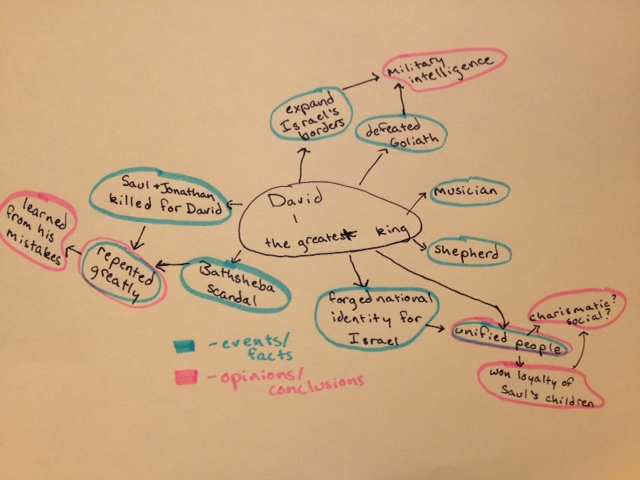by Bailey Bischoff
It can be daunting to stare at a blank page and realize that it’s up to you to fill it. It can be an even more daunting task when you aren’t sure where to start or what to say. You may have a thesis but feel unclear about how to structure your argument; or maybe it’s difficult to think about how all of your research and conclusions will flow together throughout your paper. During times like these, I find it helpful to take ten minutes or so to do a little pre-writing before I begin. It makes it easier to start writing if I have a general idea of what information I want to put in my paper.
While there are multiple techniques for pre-writing, from outlines to free writing, I will focus on a mind map here. Sometimes, in order to delve deeper and really see and analyze what you are thinking, it is good to let go of writing conventions and worrying about grammar, which may hold you back. Mind maps can help you do this because they rely on arrows and colors to relay information and connections.
A mind map is similar to techniques one can use for brainstorming. Essentially, you start with your topic, draw a circle around it, and then list all the information related to your topic in bubbles surrounding your central topic bubble. You can get creative and use different colored circles to show different types of information. You might write down a piece of information you got from a book and circle it in red, and then write down a connection you made between two pieces of information and circle it in blue. You can use arrows to help describe relationships between information as well.
The purpose of the mind map is to get your thoughts on paper and explore connections and relationships between pieces of information that you may not have even realized you were making. I find this technique especially helpful when I don’t know where to get started writing a paper, and I find myself so distracted about writing conventions that I don’t take the time to think about the argument or the connections I’m trying to make within the paper. This technique can free you from the worry of making coherent sentences so that you can focus solely on how you are thinking about your paper, your ideas.
After you have listed every piece of information connected to your paper, analyze what you have written and recognize the connections that now appear between pieces of information. Start filtering those pieces of information into more of a structured outline by dividing them into different categories, like introduction, body, and conclusion. Once you have a better idea of what your paper will look like, turn back to the blank screen; perhaps writing a paper won’t seem like such a daunting task anymore. After all, you have all of the information you need to write it.
Bailey Bischoff is a sophomore majoring in political science and global perspectives.

